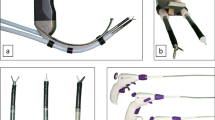Abstract
Microlaryngoscopy is the standard procedure for endolaryngeal surgery. The advantages are a steady operating field, bimanual handling and stereoscopic view in high-resolution magnification. The major drawback is that the oropharyngeal structures have to be brought into an unnatural position by the straight rigid laryngoscope with considerable forces occurring. These forces can lead to tissue injuries or even make a microlaryngoscopic operation impossible. To overcome these disadvantages, a few case studies using curved rigid laryngoscopes are published. However, there is still a lack of information to what extent curved rigid laryngoscopes could actually improve the endolaryngeal exposure with less forces occurring. It was the aim of this study to gain basic data on the forces that are needed for endolaryngeal exposure with a prototype of a curved rigid laryngoscope and to compare the occurring forces with straight laryngoscopes. In 30 consecutive patients scheduled for routine microlaryngoscopic procedures the curved laryngoscope was inserted and occurring forces were measured by a tension spring balance in four different head positions. A standard straight laryngoscope was inserted afterwards and measurements were taken again. Our results showed that the occurring forces could be reduced significantly in each head position when compared with a standard straight laryngoscope. Similarly, the anterior commissure could be exposed in a significantly higher percentage with the curved laryngoscope. In conclusion, we could show that even with a moderate-curved rigid laryngoscope a significant reduction of the forces to the oro-pharyngeal tissues can be obtained and that endolaryngeal exposure is possible in virtually all patients. Bimanual precise operations should be possible in the common way like in standard microlaryngoscopy with the only difference of not using a microscope, but operating via a monitor. We do not think that traditional microlaryngoscopy with straight instruments can or should be replaced by curved laryngoscopes, but these techniques could bridge the gap to indirect techniques in particular in specialised institutions dealing frequently with difficult patients and situations.






Similar content being viewed by others
References
Albrecht R (1954) Über den Wert kolposkopischer Untersuchungsmethoden bei Leukoplakien und Carcinomen des Mundes und des Kehlkopfes. Arch Ohren Nasen Kehlkopfheilkd 165:459–463
Czermak J (1858) Über den Kehlkopfspiegel. Wiener Medizinische Wochenschrift 8:196–198
Jako GJ (1970) Laryngoscope for microscopic observation surgery and photography. Arch Otolaryngol 91:196–199
Jelinek E (1884) Das Cocain als Anästheticum und Analgeticum für den Pharynx und Larynx. Wiener Medizinische Wochenschrift 34:1334–1337, 1364–1367
Friedrich G, Gugatschka M (2009) Influence of head positioning on the forces occurring during microlaryngoscopy. Eur Arch Otorhinolaryngol 2009 (in press)
Green H (1859) Morbid growths within the larynx. GP Putnam, New York
Gugatschka M, Gerstenberger C, Friedrich G (2008) Analysis of forces applied during microlaryngoscopy: a descriptive study. Eur Arch Otorhinolaryngol 265(9):1083–1087
Kantor E, Berci G, Parlow E, Paz-Partlow M (1991) A completely new approach to microlaryngeal surgery. Laryngoscope 101:676–679
Kantor EA, Berci G, Partlow E, Paz-Partlow M (1991) Ancillary instruments for the video microlaryngoscope. Ann Otol Rhinol Laryngol 100:317–319
Kawaida M, Fukuda H, Kohno N (2001) Video-assisted rigid endoscopic laryngosurgery: application to cases with difficult laryngeal exposure. J Voice 15(2):305–312
Kim JK, Jeong HS, HyN Kwon (2007) A new curved rigid laryngoscope to overcome the difficult laryngeal exposure (DLE) in endolaryngeal surgery. Eur Arch Otorhinolaryngol 254:901–905
Kleinsasser O (1964) Mikrochirurgie im Kehlkopf. Arch Ohrenheilkd 183:428–433
Kleinsasser O (1968) Mikrolaryngoscopy and endolaryngeal microsurgery. Saunders, Philadelphia
Kleinsasser O (1968) Mikrolaryngoskopie und endolaryngeale Mikrochirurgie. 1. Aufl. Schattauer, Stuttgart, New York
Koufman JA (2007) Introduction to office-based surgery in laryngology. Curr Opin Otolaryngol Head Neck Surg 15(6):383–386
Leden HV (1988) Microlaryngoscopy: a historical vignette. J Voice 1(4):341–346
Lesky E (1976) The Vienna medical school of the 19th century. The Johns Hopkins University Press, Baltimore
Müller A, Verges L, Schleier P, Wohlfarth M, Gottschall R (2002) The incidence of microlaryngoscopy associated complications. HNO 50(12):1057–1061 (in German)
Simpson CB, Amin MR (2004) Office-based procedures for the voice. 83 (7 Suppl 2):6–9
Skopec, Majer EH (1998) History of oto-rhino-laryngology in Austria, Christian Brandstätter Wien, München, 1998
Strong MS (1970) Microscopic laryngoscopy: a review and appraisal. Laryngoscope 91:324–326
Woo P (2006) Office-based laryngeal procedures. Otolaryngol Clin North Am 39(1):111–133
Yanagisawa E, Horowitz JB, Yanagisawa K, Mambrino LJ (1992) Comparison of new telescopic video microlaryngoscopic and standard microlaryngoscopic techniques. Ann Otol Rhinol Laryngol 101(1):51–60
Yeh AR, Huang HM, Chen YL (1999) Telescopic video microlaryngeal surgery 108:165–168
Zeitels SM, Burns JA (2007) Office-based laryngeal laser surgery with local anesthesia. Curr Opin Otolaryngol Head Neck Surg 15(3):141–147
Conflict of interest statement
The authors declare that they have no conflict of interest.
Author information
Authors and Affiliations
Corresponding author
Rights and permissions
About this article
Cite this article
Friedrich, G., Kiesler, K. & Gugatschka, M. Curved rigid laryngoscope: missing link between direct suspension laryngoscopy and indirect techniques?. Eur Arch Otorhinolaryngol 266, 1583–1588 (2009). https://doi.org/10.1007/s00405-009-0974-z
Received:
Accepted:
Published:
Issue Date:
DOI: https://doi.org/10.1007/s00405-009-0974-z




